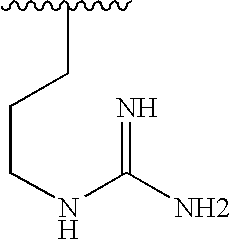Compounds useful in the treatment of anthrax and inhibiting lethal factor
a technology of anthrax and lethal factor, which is applied in the direction of drug compositions, antibacterial agents, metabolic disorders, etc., can solve the problems of high risk of contracting the disease, high risk of anthrax toxin, and rare deaths of domesticated livestock,
- Summary
- Abstract
- Description
- Claims
- Application Information
AI Technical Summary
Benefits of technology
Problems solved by technology
Method used
Image
Examples
example 1
[0079]
[0080] N-t-butoxy-2(R)-[(4-fluoro-3-methylphenylsulfonyl)]amino-3-methylbutyramide (1.8 g, 4.99 mmol) was dissolved in 75 ml of anhydrous dichloro-ethane containing ethanol (0.30 ml, 5 mmol) at 0° C. Hydrogen chloride gas was bubbled in for 30 min. The flask was closed with a septum and reaction mixture stirred for 2 days. After the solvent was removed on a rotavap, the residue was dissolved in methanol (1˜2 ml), and diluted with DCM (20 ml). The crystals formed were collected and washed with more DCM to give, after vacuum drying, N-hydroxy-2(R)-[(4-fluoro-3-methylphenylsulfonyl)]amino-3-methylbutyramide. NMR (500 MHz, CD3OD) δ: 0.86 (d, 3H), 0.91 (d, 3H), 1.86 (m, 1H), 2.30 (d, 3H), 3.30 (d, 1H), 7.16 (t, 1H), 7.67 (m, 1H), 7.72 (m, 1H).
[0081] The starting material for example 1 was prepared as follows:
[0082] D-Valine (1.39 g, 11.9 mmol) was dissolved in 80 ml of dioxane / water (1:1) containing K2CO3 (3.3 g, 24 mmol). A solution of 4-fluro-3-methylphenyl-sulfonylchloride (10...
example 2
[0084]
[0085] Example 2, N-hydroxy-2(R)-[(4-fluoro-3-methylphenylsulfonyl)]-amino-2-(4′-tetrahydropyranyl)-acetamide, was prepared from D-4′-tetrahydro-pyranylglycine in the same way as example 1. NMR (500 MHz, CD3OD) δ: 1.19 (m, 1H), 1.34 (m, 1H), 1.40 (m, 1H), 1.74(m, 1H), 1.80(m, 1H), 2.32 (d, 3H), 3.31 (m, 2H), 3.37 (d, 1H), 3.90 (m, 2), 7.18 (t, 1), 7.65 (m, 1H), 7.72 (m, 1H).
example 3 to 144
Examples 3 to 144, found in Table 1, were made on solid phase and is illustrated as follows:
[0086] Step 1. Resin Functionalization
[0087] A solution of N-hydroxyphthalimide (2.8 g, 17 mmol), DIEA (3.0 ml, 17 mmol) in dichloromethane (30 ml) and DMF (15 ml) was added quickly to 4.39 g of 2-Chlorotrityl resin (1.1 mmol / g loading) in a frit fitted cartridge. The resin suspension was shaken intermittently and left on bench overnight. The resin was washed 5× with DMF, and then treated with a 40 ml of hydrazine solution (0.5 M in THF) for 2 hr. A large amount of white solid formed around the resin. It was washed with DMF-H2O (1:1) 2×, DMP 4×. The hydrazine treatment was repeated once more for another 3 hours. The resin was washed with DMF-H2O (1:1) 2×, DMF 4×, DCM 5×, dried in vacuum overnight to give 4.53 g of resin 1. The loading is about 1.0 mmol / g by weight change.
Step 2. Loading of Amino Acid
[0088] The O-anchored hydroxylamine resin 1, 500 mg (˜1.0 mmol / g loading), was swelled...
PUM
| Property | Measurement | Unit |
|---|---|---|
| temperature | aaaaa | aaaaa |
| pH | aaaaa | aaaaa |
| width | aaaaa | aaaaa |
Abstract
Description
Claims
Application Information
 Login to View More
Login to View More - R&D
- Intellectual Property
- Life Sciences
- Materials
- Tech Scout
- Unparalleled Data Quality
- Higher Quality Content
- 60% Fewer Hallucinations
Browse by: Latest US Patents, China's latest patents, Technical Efficacy Thesaurus, Application Domain, Technology Topic, Popular Technical Reports.
© 2025 PatSnap. All rights reserved.Legal|Privacy policy|Modern Slavery Act Transparency Statement|Sitemap|About US| Contact US: help@patsnap.com



